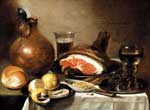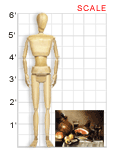VAM galleries including this work:
The Speed Art Museum | Art Through Time || VAM Home
Pieter Claesz (Dutch, 1590-1669)
BREAKFAST STILL LIFE, 1653
Oil on panel; 18-1/2" X 25"
Gift of Mrs. Berry Stoll, 75.31
The Speed Art Museum
This painting is a still life, a work of art that depicts a group of objects (non-living things). Artists create still-life paintings by placing a few household objects, such as food, flowers, or books, in an interesting arrangement, or composition. The shapes, colors, and textures of the objects and the way in which they are arranged are the sources of visual interest in a still life. In this painting, Claesz uses contrasts of light and shadow to make the jug, glasses, and lemons appear realistic in their surfaces and details.
Sometimes the objects and their arrangement in a still life create a particular mood. They may even be symbolic of a moral message or theme. For example, the abundance of food in this painting may indicate the prosperity of the era. The tipped-over glass, the precariously balanced plates, and the half-peeled lemon may all suggest that life and prosperity are temporary.
This picture was painted during the Baroque era (1580-1700). Baroque art varied widely in its style and subject matter from one European country to another. Therefore, unlike an art movement such as Impressionism, with its signature brushstrokes, Baroque painting does not have one identifiable “style.” During the Baroque period, both the physical and cultural maps of Europe began to resemble their current forms. A global economy reliant on international trade took hold, and a growing middle class began to wield some influence. The conflict between the Protestant Reformation and the Catholic Counter-Reformation, begun in the 16th century, set the stage in the Baroque period for competing types of art. In some parts of Europe, artists of the Baroque period painted dramatic pictures characterized by energy, tension, and sharp contrasts of light and dark. In northern Europe, however, Baroque artists focused instead on portraying scenes from ordinary life in painstaking detail.
In Holland, where Breakfast Still Life was painted, the use of religious imagery declined as a result of the Protestant Reformation. (Protestants believed that religious paintings violated the Second Commandment against worshipping graven images.) Thus Dutch artists produced landscapes, portraits, and still lifes, like this breakfast piece.
About the Artist
Born in Germany, Pieter Claesz moved to Haarlem in the Netherlands in 1617 and remained there for the rest of his life. He lived at a time when the Dutch enjoyed great prosperity due to their dominance of world trade and shipping. Holland had a large, literate middle class that was willing and able to buy original oil paintings to decorate their homes. In fact, many artists were able to specialize in particular types of painting; Claesz specialized in breakfast still-life pieces like this one. He is also known for working in a low-key, almost monochromatic palette of subtle grays, browns, and greens, with yellow accent often provided by a lemon.
Classroom Ideas
Discussion: List foods that you commonly have for breakfast. Do concerns of nutrition and a “balanced diet” affect your choice? What other items tend to be on the table (such as silverware, seasonings, tablecloth, or napkins)? Then list the objects you see in Breakfast Still Life. Claesz used the same items—bread, cheese, wine, ham, and lemon—in many of his paintings. Look at a variety of Claesz still lifes and compare how the items are arranged and the colors used. How does this painting differ from others by Claesz?
Watch the video segment of education curator Martin Rollins analyzing this work in Responding to Visual Art. Compare your response to his.
Research the use of symbolism in still lifes. Why do you think the breakfast of the Dutch became a popular subject for still lifes? (The meal might represent sustenance; the meal could represent the range of experiences of life, just as there are different objects positioned in the still life; a simple meal could represent the desire for a simple life, etc.) What other possible symbolism might be found within this piece? What else might the items represent? Think about contemporary advertisements and how you are constantly bombarded by images on billboards, TV, the Internet, and magazines. What does it take to entice and attract a viewer/buyer for a product or service? What might this painting advertise if it were seen in today’s world?
Activities: Set up a breakfast still life using food and objects we would use today, then draw or paint it. (You can look at Claesz images for a traditional approach to painting a still life or at works by artists such as Wayne Thiebaud, Andy Warhol, and Janet Fish for a more contemporary approach.) Write a reflective narrative about the choices you made for your “breakfast still life.”
From what you can learn from other still-life works by Claesz or other Dutch artists of the 17th century, compare that time to the present. Write a story or a poem about Claesz’ breakfast scene. Whose breakfast was this? What were the events or precipitating factors that made the person leave the meal only half eaten?
Links
Visit the Getty Museum for more information about Pieter Claesz as well as images of his work.
[www.getty.edu/art/collections/bio/a346-1.html]
See more examples of Claesz still lifes at the Web Gallery of Art.
[gallery.euroweb.hu/html/c/claesz/]
Find links to online works by Claesz as well as background on the Baroque era in the Artcyclopedia.
[www.artcyclopedia.com/artists/claesz_pieter.html]
[www.artcyclopedia.com/history/baroque.html]

